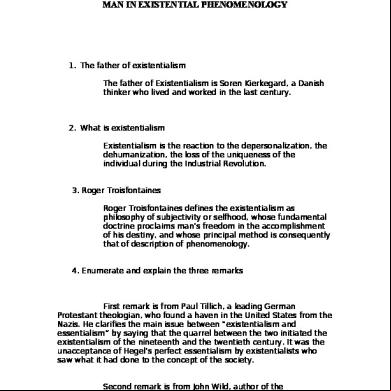Phenomenology 86ql
This document was ed by and they confirmed that they have the permission to share it. If you are author or own the copyright of this book, please report to us by using this report form. Report 3i3n4
Overview 26281t
& View Phenomenology as PDF for free.
More details 6y5l6z
- Words: 815
- Pages: 24
REVIEW OF LITERATURE The
rationale for postponing the literature review is related to the goal of achieving a pure description of the phenomenon under the investigation.
TRUSTWORTHINESS AND AUTHENTICITY OF DATA
Put
to study participants depends on the extent to which they tap the participants’ experiences apart from the participants’ theoretical knowledge of the topic. Consistent use of the method and bracketing prior knowledge helps to ensure pure description of data.
TRUSTWORTHINESS AND AUTHENTICITY OF DATA Requesting
negative descriptions of the phenomenon under investigation is helpful in establishing authenticity and trustworthiness of the data
PHENOMENOLOGY IN PRACTICE, EDUCATION & ISTRATION
Very
often in nursing we are faced with practice, education and istrative experiences that seem to present patterns that are familiar to us. In order to validate our perceptions research must be conducted to explore and describe the phenomenon fully and accurately.
APPLICATION TO PRACTICE Many
nursing interventions performed in clinical settings lend themselves to quantitative measurement. Subjective phenomena unique to the practice of professional nursing need investigate approaches suitable to their unique nature.
APPLICATION TO PRACTICE Phenomenology
as a qualitative research method has been used to explore a variety of practice-related experiences and facilitates understanding of subjective interactive experiences.
APPLICATION TO PRACTICE Nurse
are in a prime position to identify issues related to nursing practice that need to be understood and described more fully. Example: “The Experience of Caring for a Family Member with Alzheimer’s Disease” by Butcher et al.
APPLICATION TO PRACTICE Butcher
et al. (2001) emphasize the need for a qualitative research design , noting that “the bulk of ADRD family caregiving research has been conducted by means of surveys, and closed-ended interview methods that rely heavily on standardized psychometric instruments including
various depression and anxiety scales, caregiver burden scales, symptom checklists, and structural diagnostic assessment tool”
APPLICATION TO PRACTICE ‘One
of the unique features of van Kaam’s phenomenological method is the reporting of frequencies and percentages of the participants for each of the preliminary structural elements and essential structural elements.
APPLICATION TO PRACTICE Data
analysis was described in detail and followed the rigorous research methodology described by van Kaam. The steps of van Kaam are used to clarify how essential and preliminary structural elements were developed and percentages calculated.
APPLICATION TO EDUCATION Nursing
education also lends itself to objective and subjective research interests. Test construction and critical thinking are education – related examples that are appropriate for quantitaive investigation, although not exclusively.
APPLICATION TO EDUCATION The
educational domain of nursing also lends itself to qualitative investigation in areas such as educational experiences, caring and the curriculum, or the effect of evaluation on student performance in the clinical setting.
APPLICATION TO EDUCATION Nursing
education is an important area of research that can be studied using qualitative approaches. Example: “Technological Competence as a Fundamental Structure of Learning in Critical Care Nursing: A Phenomenological Study” by Little (2000)
APPLICATION TO EDUCATION Little
(2000) described her participant selection in detail. Her selection process ed a qualitative framework in that it was purposeful, and subjects had experience with the phenomenon under investigation.
APPLICATION TO EDUCATION Little
(2000) also addresses the protection of human subjects and she notes that ethical principles were honored. The data collection strategies use by Little (2000) phenomenological approaches to description, discovery, and understanding.
APPLICATION TO ISRATION There
is limited literature on studies related to nursing istration that use qualitative approaches.
APPLICATION TO ISRATION The
development of qualitative research that describes phenomena important to nursing istration might include research that examines professional nurse behavior and work satisfaction, successful leadership strategies, and perspective on nurse empowerment.
APPLICATION TO ISRATION Example
study: “Management from Four Different Perspectives” by Lindholm, Uden, and Rastam (1999) is presented as an example of the application of qualitative research in the area of istration.
APPLICATION TO ISRATION The
phenomenon of interest, identified in the study, focused on gaining an understanding of the process of nursing management in a developing organization.
APPLICATION TO ISRATION The
purpose of the study was to “illuminate nursing management in a developing organization from the perspectives of nurse managers, chief physicians, hospital doctors and politicians respectively” (Lindholm et al., 1999). The authors make explicit their purpose and it with a review of the literature.
APPLICATION TO ISRATION The
sample included 15 nurse managers, 11 chief physicians, and three politicians who were chairmen of the local health boards. “The nurse managers were all women, except for one. In the other groups all the participants were men” (Lindholm et al, 1999)
The
APPLICATION TO ISRATION
method used to collect data was compatible with the research purpose and adequately addressed the phenomena of interest. The findings demonstrate the participants’ realities and the researchers relate the findings of the study to what is already known.
rationale for postponing the literature review is related to the goal of achieving a pure description of the phenomenon under the investigation.
TRUSTWORTHINESS AND AUTHENTICITY OF DATA
Put
to study participants depends on the extent to which they tap the participants’ experiences apart from the participants’ theoretical knowledge of the topic. Consistent use of the method and bracketing prior knowledge helps to ensure pure description of data.
TRUSTWORTHINESS AND AUTHENTICITY OF DATA Requesting
negative descriptions of the phenomenon under investigation is helpful in establishing authenticity and trustworthiness of the data
PHENOMENOLOGY IN PRACTICE, EDUCATION & ISTRATION
Very
often in nursing we are faced with practice, education and istrative experiences that seem to present patterns that are familiar to us. In order to validate our perceptions research must be conducted to explore and describe the phenomenon fully and accurately.
APPLICATION TO PRACTICE Many
nursing interventions performed in clinical settings lend themselves to quantitative measurement. Subjective phenomena unique to the practice of professional nursing need investigate approaches suitable to their unique nature.
APPLICATION TO PRACTICE Phenomenology
as a qualitative research method has been used to explore a variety of practice-related experiences and facilitates understanding of subjective interactive experiences.
APPLICATION TO PRACTICE Nurse
are in a prime position to identify issues related to nursing practice that need to be understood and described more fully. Example: “The Experience of Caring for a Family Member with Alzheimer’s Disease” by Butcher et al.
APPLICATION TO PRACTICE Butcher
et al. (2001) emphasize the need for a qualitative research design , noting that “the bulk of ADRD family caregiving research has been conducted by means of surveys, and closed-ended interview methods that rely heavily on standardized psychometric instruments including
various depression and anxiety scales, caregiver burden scales, symptom checklists, and structural diagnostic assessment tool”
APPLICATION TO PRACTICE ‘One
of the unique features of van Kaam’s phenomenological method is the reporting of frequencies and percentages of the participants for each of the preliminary structural elements and essential structural elements.
APPLICATION TO PRACTICE Data
analysis was described in detail and followed the rigorous research methodology described by van Kaam. The steps of van Kaam are used to clarify how essential and preliminary structural elements were developed and percentages calculated.
APPLICATION TO EDUCATION Nursing
education also lends itself to objective and subjective research interests. Test construction and critical thinking are education – related examples that are appropriate for quantitaive investigation, although not exclusively.
APPLICATION TO EDUCATION The
educational domain of nursing also lends itself to qualitative investigation in areas such as educational experiences, caring and the curriculum, or the effect of evaluation on student performance in the clinical setting.
APPLICATION TO EDUCATION Nursing
education is an important area of research that can be studied using qualitative approaches. Example: “Technological Competence as a Fundamental Structure of Learning in Critical Care Nursing: A Phenomenological Study” by Little (2000)
APPLICATION TO EDUCATION Little
(2000) described her participant selection in detail. Her selection process ed a qualitative framework in that it was purposeful, and subjects had experience with the phenomenon under investigation.
APPLICATION TO EDUCATION Little
(2000) also addresses the protection of human subjects and she notes that ethical principles were honored. The data collection strategies use by Little (2000) phenomenological approaches to description, discovery, and understanding.
APPLICATION TO ISRATION There
is limited literature on studies related to nursing istration that use qualitative approaches.
APPLICATION TO ISRATION The
development of qualitative research that describes phenomena important to nursing istration might include research that examines professional nurse behavior and work satisfaction, successful leadership strategies, and perspective on nurse empowerment.
APPLICATION TO ISRATION Example
study: “Management from Four Different Perspectives” by Lindholm, Uden, and Rastam (1999) is presented as an example of the application of qualitative research in the area of istration.
APPLICATION TO ISRATION The
phenomenon of interest, identified in the study, focused on gaining an understanding of the process of nursing management in a developing organization.
APPLICATION TO ISRATION The
purpose of the study was to “illuminate nursing management in a developing organization from the perspectives of nurse managers, chief physicians, hospital doctors and politicians respectively” (Lindholm et al., 1999). The authors make explicit their purpose and it with a review of the literature.
APPLICATION TO ISRATION The
sample included 15 nurse managers, 11 chief physicians, and three politicians who were chairmen of the local health boards. “The nurse managers were all women, except for one. In the other groups all the participants were men” (Lindholm et al, 1999)
The
APPLICATION TO ISRATION
method used to collect data was compatible with the research purpose and adequately addressed the phenomena of interest. The findings demonstrate the participants’ realities and the researchers relate the findings of the study to what is already known.






